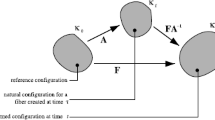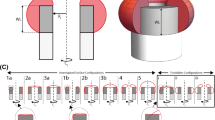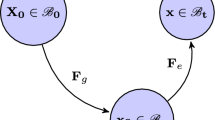Abstract
We analyze the mathematical properties of the fibrous capsule tissue concentration around a disk-shaped implant. We establish stability estimates as well as monotonicity results that illustrate the sensitivity of this growth to the biocompatibility index parameters of the implant. In addition, we prove that the growth of the tissue increases exponentially in time toward an asymptotic regime. We also study the mathematical properties of the solution of the inverse problem consisting in the determination of the values of the biocompatibility index parameters from the knowledge of some fibrous capsule tissue measurements. We prove that this model calibration problem admits a unique solution, and establish a characterization of the index parameters. Furthermore, we demonstrate analytically that such a solution is not continuous with respect to the data, and therefore the considered inverse problem is ill-posed due to the lack of the stability requirement.
Similar content being viewed by others
References
Adams RA (1975) Sobolev spaces. Academic Press, New York
Anderson JM (2001) Biological responses to materials. Annu Rev Mater Res 31:81–110
Berger MS (1977) Nonlinearity and functional analysis. Academic Press, New York
Brezis H (1983) Analyse fonctionnelle. Théorie et applications. Dunod, Paris
Hadamard J (1923) Lectures on Cauchy’s problem in linear partial differential equations. Yale University Press, New Haven
Kontio R, Ruuttila P, Lindroos L, Suuronen R, Salo A, Lindqvist C, Virtanen I, Konttinen YT (2005) Biodegradable polydioxanone and poly(L/D)lactide implants: an experimental study on peri-implant tissue response. J Oral Maxillofac Surg 34:766–776
Lehle K, Lohn S, Reinerth G, Schubert T, Preuner JG, Birnbaum DE (2004) Cytological evaluation of the tissue–implant reaction associated with subcutaneous implantation of polymers coated with titaniumcarboxonitride in vivo. J Biomater 25:5457–5466
Li DJ, Ohsaki K, Li K, Cui PC, Ye Q, Baba K, Wang QC, Tenshin S, Yamamoto TT (1999) Thickness of fibrous capsule after implantation of hydroxyapatite in subcutaneous tissue in rats. J Biomed Mater Res 45:322–326
Lions JL, Magenes E (1971) Non-homogeneous boundary value problems and applications I and II. Springer, Berlin
Pazy A (1983) Semigroups of linear operators and applications to partial differential equations. Applied Mathematical Series 44. Spinger, New York
Potter M, Weinberger H (1967) Maximum principle in differential equations. Prentice-Hall, Englewood Cliffs, NJ
Rauch J (1991) Partial differential equations. Springer, Berlin
Ravin AG, Olbrich KC, Levin LS, Usala A-I, Klizman B (2001) Long- and short-term effects of biological hydrogels on capsule microvascular density around implants in rats. J Biomed Mater Res 58:313–318
Ryan P (2007) A mathematical and laboratory investigation of an electrical current-based method for disrupting the growth of fibrous tissue around biomaterial implants. J Master’s thesis California State University Northridge
Ryan P, Djellouli R, Cohen R (2008) Modeling capsule tissue growth around disk-shaped implants: a numerical and in vivo study. J Math Biol 57:675–695
Sanders JE, Bale SD, Neumann T (2002) Tissue response to microfibers of different polymers: polyester, polyethylene, polylactic acid, and polyurethane. J Biomed Mater Res 62:222–227
Taylor ME (1997) Partial differential equations I. Springer, Berlin
Tikhonov AN (1963) Regularization of incorrectly posed problems. Soviet Math Doklady 4:1624–1627
Tikhonov AN, Arsenin VY (1977) Solutions of ill-posed problems. Winston and Sons, Washington
Zhu CS, Ohsaki K, Li K, Ye Q, Trn YH, Ohba Y, Moriyama K (1999) Long-term observation of subcutaneous tissue reaction to synthetic auditory ossicle (Bioceram©) in rats. J Med Investig 46:97–103
Acknowledgments
The first author acknowledges the support of MiniMed/Medtronic and the office of Graduate Studies at CSUN under grant# E1515. Some of this work was conducted while the first author was visiting the Mathematical and Computer Sciences and Engineering Division at the King Abdullah University of Science and Technology. He also would like to thank KAUST for its generous hospitality. Any opinions, findings, conclusions, or recommendations expressed in this material are those of the authors and do not necessarily reflect the views of MiniMed/Medtronic or of the office of Graduate Studies at CSUN, or KAUST.
Author information
Authors and Affiliations
Corresponding author
Appendices
Appendix A: Norm estimates and additional properties
We present in this section auxiliary results pertaining to (a) the equivalence of the norms employed in this paper, and (b) concentration results. The proofs are simple exercises in functional analysis, and they are included only for completeness.
The following lemma provides Poincaré–Friedrichs type inequalities (see, e.g., Brezis 1983) that will be used to prove the equivalence between the norms.
Lemma 3
Let \(v \in V = \left\{ v\in H^1(\Omega )~; \quad v(L) = 0 \right\} \). Then, we have:
Proof
First, observe that for \(v \in V\), we have \(v(L) = 0\), and therefore:
Hence, using Cauchy–Schwarz inequality, we deduce that:
which proves Eq. (50). In addition, it follows from integrating Eq. (53) that:
which proves Eq. (49).
Next, we prove Eq. (51). We have:
Hence, using Young inequality, we deduce that:
Property A.1. Consider the following scalar product on \(V \times V\):
and
Then, the corresponding norms denoted by \(\Vert \cdot \Vert _3\) and \(\Vert \cdot \Vert _4\) respectively are equivalent to \(\Vert \cdot \Vert _{H^{1}(\Omega )}\), the standard \(H^{1}\)-norm.
Proof
First, observe that it is easy to deduce from (49) that:
Moreover, it follows from Eq. (50) that:
Consequently, it results from Eq. (59) and Eq. (60) that the norms \(\Vert \cdot \Vert _3 \) and \(\Vert \cdot \Vert _{H^{1}(\Omega )}\) are equivalent. Furthermore, it follows from the definition given by Eqs. (57) and (58) that:
which proves the equivalence between the norms \(\Vert \cdot \Vert _3\) and \(\Vert \cdot \Vert _4\) and therefore equivalent to \(\Vert \cdot \Vert _{H^{1}(\Omega }\).
Lemma 4
The vector space \(W \!= \!\left\{ w\in H^2(\Omega ); w(L) \!=\! 0~\mathrm {and}~ w^{\prime }(0)-c_4w(0) = 0 \right\} \) is dense in the vector space \(V= \left\{ v\in H^1(\Omega ); \quad v(L) = 0 \right\} \).
Proof
For \(v\in V\), we consider the sequence \(\left(v_n\right)_{n \ge 1}\) satisfying the following boundary value problem:
We also consider the following variational problem corrsponding to the boundary value problem given by (62):
where
and
Using the previous norm equivalent results (see Property A.1), it is then easy to check that the variational problem given by (63) admits a unique solution \(v_n \in W\). Next, we prove that the sequence \((v_n)_{n\ge 1}\) converges to \(v\) in \(V\).
First, we substitute \(\varphi = v_n\) into the variational problem (63), and then integrate by parts. We obtain:
Second, we apply successively Cauchy–Schwarz and Young inequalities to bound the right-hand side. We obtain:
Consequently, we deduce:
Using again the variational problem (63) for \(\varphi \in \mathfrak D (\Omega )\) along with the estimates given by (68), we deduce that:
Moreover, since \(\mathfrak D (\Omega )\) is dense in \(L^2(\Omega )\) (se, e.g., Brezis 1983; Lions and Magenes 1971; Taylor 1997), it follows that the sequence \((v_n)_{n\ge 1}\) converges weakly to \(v\) into \(L^2(\Omega )\). Furthermore, it follows from using the variational problem (63) with \(\varphi =- (e^{-c_2x^2}v^{\prime }_{n})^{\prime }\), and then integrating by parts, that:
On the other hand, since \(c_4 > 0\), the following:
defines a scalar product on \(V \times V\), and its corresponding norm, denoted by \(\Vert .\Vert _5\), is equivalent to the norm \(\Vert .\Vert _4\) given by Eq. (58) in Property A.1 (which is then equivalent to the standard \(H^1\)-norm). Consequently, it follows from Eq. (69) that:
Hence, the sequence \((v_n)_{n\ge 1}\) converges weakly to \(v\) in \(H^1(\Omega )\). Finally, using the inequality \(\Vert v_n\Vert _5\le \Vert v\Vert _5\) allows to conclude that this convergence is in fact in the strong sense.
Appendix B: Properties of the solution of BVP (2)
We have already established the existence and the uniqueness of the solution \(v\) of the boundary value problem BVP (2) (see Lemma 1). The goal here is to study the properties of the solution \(v\) and to derive stability. These results do not appear to be standard and they may be of independent interest. These results are formulated in the following three lemmas.
Lemma 5
The solution \(v\) of the boundary value problem BVP (2) satisfies the following properties:
-
i.
\(\forall \,x\,\in [0,L[: \quad 0< v(x) \le v(0)<1.\)
-
ii.
\(||v||^2_{L^{2}(\Omega )}\,\le \,K_0; \quad {where} \quad K_0 = \min \left\{ L, \frac{c_1c_4}{4c_3}, \frac{L^2c_4}{8}e^{c_2L^2}, \frac{L^2}{2}(\frac{c_4}{4}+c_2L)\right\} .\)
Proof
We set the variational problem given by Eqs. (4–6) with \(\varphi = v\), that is:
Therefore, \(v(0) > 0\) (otherwise \(v \equiv 0\)). Moreover, by re-writing Eq. (70) as follows:
we deduce that \(v(0) < 1\) (otherwise \(v \equiv 0\)). Next, we consider the boundary value problem BVP (2). We multiply the first equation by \(v\) and integrate by parts over \([a, L[\), for \(a \ge 0\). We obtain:
Therefore, we must have \(v(a)v^{\prime }(a) < 0\) for all \(a \ge 0\) (otherwise \(v (x) = 0\) on some interval \(]a, L[\), which necessarily makes \(v \equiv 0\)). Consequently, we must have:
and therefore:
In the following, we prove property (ii). First, observe that it follows from property (i.) that :
In addition, using Eq. (71) and the fact that \(c_1c_4\,v(0)(1-v(0))\, \le \,\frac{c_1c_4}{4}\), we deduce that:
Furthermore, it follows from the Friedrichs–Poincaré inequality given by Eq. (49) in Lemma 3, and Eq. (74) that:
Moreover, we obtain from the variational problem given by Eqs. (4–6), in which we set \(\varphi = e^{c_2x^2}v\) and integrate by parts over \(\Omega \), that:
Since \(c_1c_4v(0)\le c_1c_4(v(0))^2+\frac{c_1c_4}{4}\), and using property (i.), we deduce that:
and therefore,
Using again the Friedrichs–Poincaré inequality given by Eq. (49) in Lemma 3, we deduce that:
Lemma 6
The first derivative \(v^{\prime }\) of the solution of the boundary value problem BVP (2) satisfies:
-
i.
\(\forall \,x\,\in [0,L[: \quad v^{\prime }(x)<0.\)
-
ii.
\(||v^{\prime }||^2_{L^{2}(\Omega )}\le K_1\) where \(K_1\,= \,\min \left\{ \frac{c_4}{4}e^{c_2L^2}, \frac{c_4}{4}+c_2L\right\} .\)
-
iii.
\(x \longrightarrow e^{-c_2x^2}v^{\prime }(x)\) is negative and increasing on \(\Omega \), and satisfies \(\sup _{x \in \Omega }\big |e^{-c_2x^2} v^{\prime }(x)\big | < \,c_4\).
Proof
The property (i.) (resp. property (ii.)) has already been established in the proof of Lemma B.1 [see Eq. (73), (resp. Eq. (74) and Eq. (78))].
Next, we prove property (iii.). It follows from the first equation of the boundary value problem BVP (2) that \(x \longrightarrow e^{-c_2x^2}v^{\prime }(x)\) is a negative and an increasing function on \(\Omega \). In addition, using the boundary condition of BVP (2), we deduce that \(\sup _{x \in \Omega }\left|e^{-c_2x^2}v^{\prime }(x)\right|\,\le \,|v^{\prime }(0)| = c_4(1-v(0)) < c_4\).
Lemma 7
The second derivative of \(v\), the solution of the boundary value problem BVP (2), satisfies:
where
Proof
It follows from the first equation of the boundary value problem BVP (2) that:
Hence, using Young inequality, we deduce that:
Consequently, we have:
Thus,
Finally, using property (ii.) of Lemma 6 and Eq. (77), we obtain that:
Appendix C: Properties of the solution of IBVP (3)
This section is devoted to the analysis of the properties of the solution of the homogenous initial boundary value problem BVP(2). We present useful stability estimates on the solution \(w\) of the initial boundary value problem IBVP(3). These results are based on the estimates established in Appendix B. They are formulated in the following three lemmas.
Lemma 8
The solution \(w\) of the initial boundary value problem IBVP(3) (or (8)) satisfies the following estimate:
where \(K_0\) is defined in Lemma 5, and the positive constant \(\beta \) is given by:
Proof
First, observe that:
Then, using the Friedrichs–Poincaré inequality given by Eq. (50), we obtain:
Hence, it follows from subtituting Eq. (84) into Eq. (12) (in which \(w_n\) is replaced by \(w\)) that:
where the positive function \(Y(t)\) is given by:
Moreover, we have:
Therefore, we deduce that:
which is equivalent to:
that is:
The use of Lemma 5 concludes the proof.
Lemma 9
The solution \(w\) of the initial boundary value problem IBVP(3) (or (8)) satisfies the following estimate:
Proof
We set:
Hence, it follows from Eq. (15) that:
Therefore, we have:
On the other hand, we have:
Hence, it follows from the variational problem given by Eqs.(4–6) that:
Finally, using Lemma 5, we deduce:
Consequently, we have just established the following a priori estimate:
The use of \(e^{-c_2x^2} \ge e^{-c_2L^2}\) for any \(x \in \Omega \) allows to conclude the proof of Lemma 6.
Lemma 10
The solution \(w\) of the initial boundary value problem IBVP(3) (or (8)) satisfies the following estimate:
where the positive constant \(K_3\) is given by:
Proof
For any positive number \(T\), we integrate Eq. (15) over \(]0, T[\). We then obtain:
where \(Z(t)\) is given by Eq. (87) in the proof of Lemma 9.
Hence, for \(T \longrightarrow \infty \), it follows from Eqs. (89) and (90) that:
On the other hand, we also have:
Thus, using Young’s inequality, we obtain that:
Since \(x \in \Omega = ]0, L[\), we deduce that:
Finally, substituting Eq. (86) and Eq. (92) into Eq. (93) concludes the proof of Lemma 10.
Rights and permissions
About this article
Cite this article
Djellouli, R., Mahserejian, S., Mokrane, A. et al. Theoretical study of the fibrous capsule tissue growth around a disk-shaped implant. J. Math. Biol. 67, 833–867 (2013). https://doi.org/10.1007/s00285-012-0566-1
Received:
Revised:
Published:
Issue Date:
DOI: https://doi.org/10.1007/s00285-012-0566-1
Keywords
- Biomaterial implants
- Fibrous capsule formation
- Stability estimates
- Maximum principle
- Contraction semigroups
- Elliptic equations
- Parabolic equations
- Inverse identification problem
- Ill-posed problem




